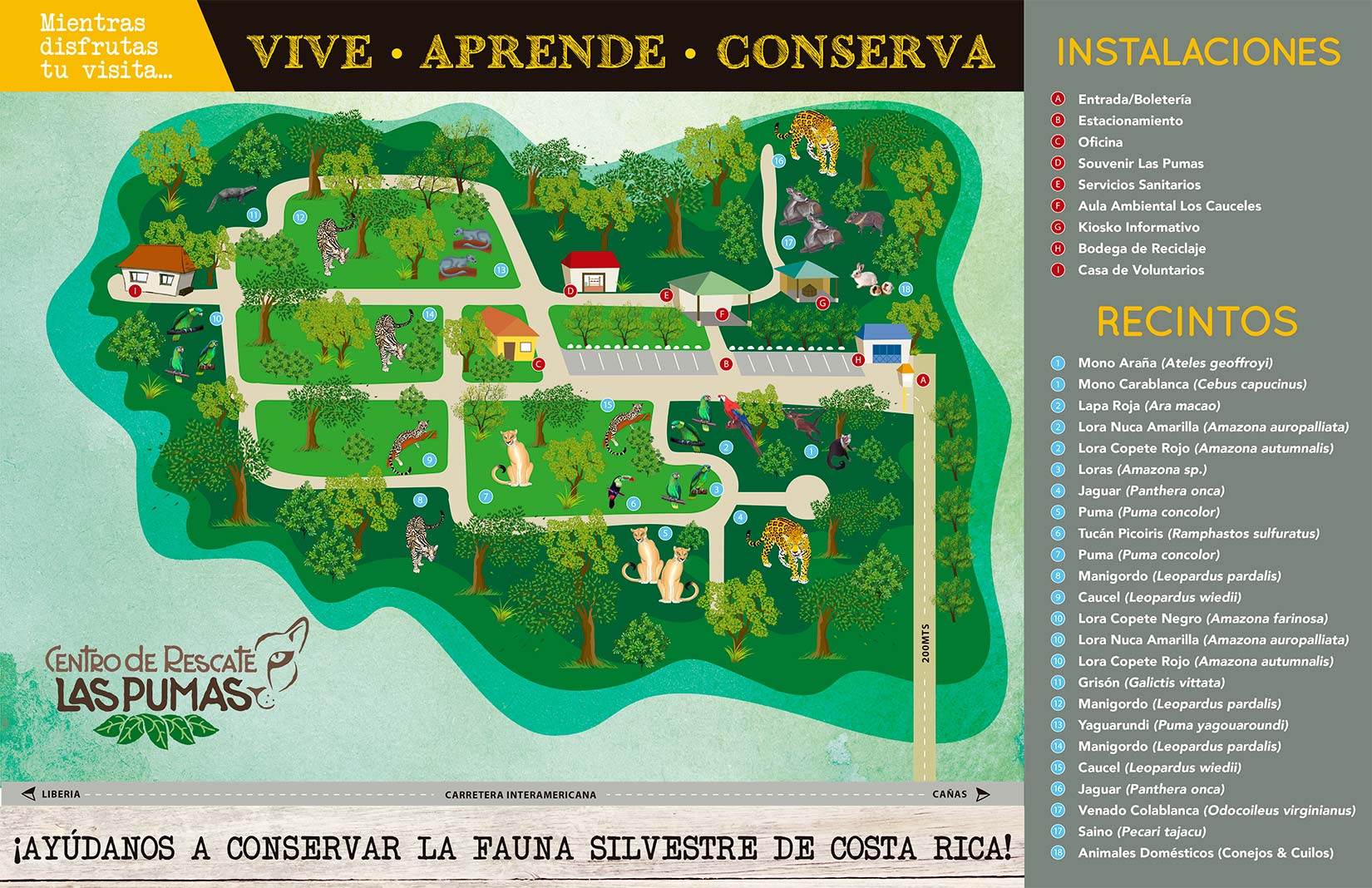We like to say that in nature, there are no guarantees. What that means is that, while Costa Rica is an incredibly biodiverse country where more than 25% of all land is reserved for national parks, wildlife refuges, and reserves – habitats to some of the densest wild animal populations in the world – there's no guarantee you'll spot a specific animal. Especially if that animal is elusive. Enter Las Pumas Rescue Center, or El Centro de Rescate Las Pumas.
Las Pumas is a wildlife rescue center, taking in the injured, the orphaned, and the illegally captured. Their goal: To provide necessary medical care and rehabilitate these animals, hopefully for release back into their natural habitats. What this means for us: Guaranteed animal sightings and a feel-good, do-good kind of day, where you not only see some animals but put your tourism dollars toward a worthy nonprofit.

It's in the name: Las Pumas Rescue Center rescues wildlife, providing medical care and temporary homes to those in need of rehabilitation. In extreme cases, this temporary home may become permanent. A brief but interesting history: Las Pumas Rescue Center was founded in the 60s, when farming was booming and deforestation in Guanacaste (our province) was at its peak. (We've thankfully turned this around, over the last several decades.) Habitat loss followed and, with it, the plight of many wild animals – especially big cats, which require a large (and, often solitary) range. Around the same time, spouses Werner Hagnauer and Lilly Bodmer de Hagnauer had emigrated from Switzerland to live and work in the region. Lilly was a conservationist, and so her neighbors began to bring her wild animals – those displaced by habitat loss, injured, or illegally taken as pets. Soon, even employees of the Ministry of Environment and Energy (MINAE, then MIRENEM), began to rely on "Mrs. Lilly." On occasion, she would even purchase illegal pets to save them from their fates. Within a few years, their rescue center had grown to more than 150 animals, including wild cats, monkeys, birds, and more. By 1985, the Hagnauers' efforts had grown to 25 hectares (61 acres); in 1989, they officially founded Las Pumas Rescue Center, as we know it today. Though "Mrs. Lilly" passed in 2001, to this day, the nonprofit Hagnauer Foundation runs the rescue center.
Animals – lots of them! But first, let's talk zoos. Did you know that Costa Rica has eliminated its zoos? And, by that, Costa Rican law means that animals cannot be captured and/or kept purely for our viewing pleasure. In practice, of course, many wildlife rescues allow visitors to view wild animals – but this purpose is secondary. The animals you see in Costa Rica's refuges and rescues are just that: rescued. That is the primary and most important purpose of any rescue center. These animals were injured, kept as pets, or orphaned, and must now be rehabilitated, hopefully for release back into the wild. They will not live at the rescue center forever, unless they are incapable of surviving in the wild. And that's one of the things we love about Las Pumas: the enclosures are spacious and clean, mimicking the animals' natural environment. If they can live in the wild again, they'll feel right at home.
Need to Know:
Location: About 2 hours east of Tamarindo and 4.5 miles outside of Cañas, on the Interamerican Highway en route to Liberia Hours: 8:00 a.m. to 4:00 p.m., Monday-Sunday Cost: $8 children & students / $12 adultsAbout Las Pumas Rescue Center (El Centro de Rescate Las Pumas)

It's in the name: Las Pumas Rescue Center rescues wildlife, providing medical care and temporary homes to those in need of rehabilitation. In extreme cases, this temporary home may become permanent. A brief but interesting history: Las Pumas Rescue Center was founded in the 60s, when farming was booming and deforestation in Guanacaste (our province) was at its peak. (We've thankfully turned this around, over the last several decades.) Habitat loss followed and, with it, the plight of many wild animals – especially big cats, which require a large (and, often solitary) range. Around the same time, spouses Werner Hagnauer and Lilly Bodmer de Hagnauer had emigrated from Switzerland to live and work in the region. Lilly was a conservationist, and so her neighbors began to bring her wild animals – those displaced by habitat loss, injured, or illegally taken as pets. Soon, even employees of the Ministry of Environment and Energy (MINAE, then MIRENEM), began to rely on "Mrs. Lilly." On occasion, she would even purchase illegal pets to save them from their fates. Within a few years, their rescue center had grown to more than 150 animals, including wild cats, monkeys, birds, and more. By 1985, the Hagnauers' efforts had grown to 25 hectares (61 acres); in 1989, they officially founded Las Pumas Rescue Center, as we know it today. Though "Mrs. Lilly" passed in 2001, to this day, the nonprofit Hagnauer Foundation runs the rescue center.
What You'll See at Las Pumas Rescue Center

Animals – lots of them! But first, let's talk zoos. Did you know that Costa Rica has eliminated its zoos? And, by that, Costa Rican law means that animals cannot be captured and/or kept purely for our viewing pleasure. In practice, of course, many wildlife rescues allow visitors to view wild animals – but this purpose is secondary. The animals you see in Costa Rica's refuges and rescues are just that: rescued. That is the primary and most important purpose of any rescue center. These animals were injured, kept as pets, or orphaned, and must now be rehabilitated, hopefully for release back into the wild. They will not live at the rescue center forever, unless they are incapable of surviving in the wild. And that's one of the things we love about Las Pumas: the enclosures are spacious and clean, mimicking the animals' natural environment. If they can live in the wild again, they'll feel right at home.


